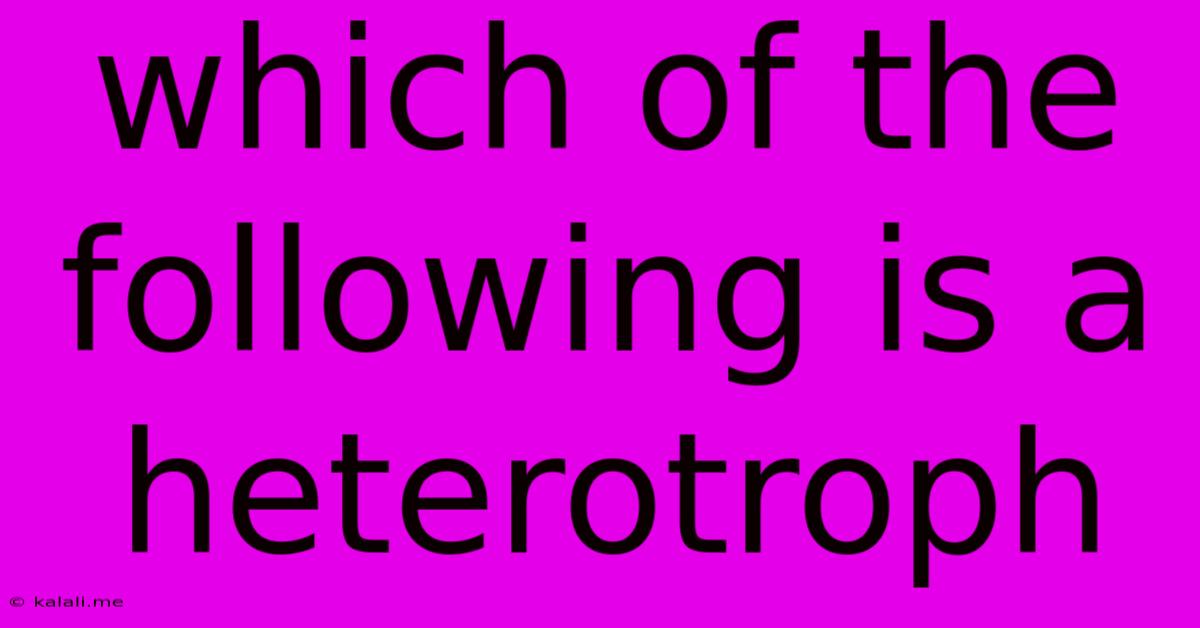Which Of The Following Is A Heterotroph
Kalali
Jun 14, 2025 · 2 min read

Table of Contents
Which of the Following is a Heterotroph? Understanding Heterotrophic Organisms
This article explores the concept of heterotrophs, contrasting them with autotrophs and providing clear examples to help you easily identify them. Understanding the difference between these nutritional types is fundamental to grasping basic biology. This guide will clarify the definition of a heterotroph and offer ways to distinguish them from autotrophs in various scenarios.
What is a Heterotroph?
A heterotroph is an organism that cannot produce its own food. Unlike autotrophs (like plants), which use sunlight, water, and carbon dioxide to create their own energy through photosynthesis, heterotrophs must obtain their energy by consuming other organisms. This means they rely on organic carbon sources for nourishment and growth. This makes them vital parts of the food chain, acting as consumers.
Key Characteristics of Heterotrophs:
- Dependence on other organisms: Heterotrophs are entirely dependent on consuming other living things for their energy needs. This can range from consuming plants to consuming other animals.
- Organic carbon source: They obtain their carbon from organic molecules found in other organisms, rather than inorganic sources like carbon dioxide.
- Diverse feeding strategies: Heterotrophs exhibit a wide variety of feeding methods, including herbivory (plant-eating), carnivory (meat-eating), omnivory (eating both plants and animals), and detritivory (feeding on dead organic matter).
Examples of Heterotrophs:
Heterotrophs encompass a vast range of organisms, including:
- Animals: From the smallest insects to the largest whales, animals are almost universally heterotrophic. Examples include lions, tigers, bears, humans, dogs, cats, and birds.
- Fungi: Fungi, such as mushrooms and molds, obtain nutrients by absorbing organic matter from their environment, often through decomposition.
- Many Protists: Certain single-celled organisms, like amoebas and paramecium, are heterotrophic, consuming bacteria or other protists.
- Most Bacteria: While some bacteria are autotrophic, a significant portion are heterotrophic, deriving energy from organic molecules.
Heterotrophs vs. Autotrophs: A Comparison
| Feature | Heterotroph | Autotroph |
|---|---|---|
| Food Source | Consumes other organisms | Produces its own food |
| Energy Source | Organic molecules from other organisms | Sunlight (photosynthesis) or chemical reactions |
| Carbon Source | Organic molecules | Inorganic carbon dioxide (CO2) |
| Examples | Animals, fungi, most bacteria, some protists | Plants, some bacteria, algae |
Identifying a Heterotroph:
When presented with a list of organisms, consider their method of obtaining nutrients. If the organism doesn't produce its own food and instead consumes other organisms or organic matter, it's a heterotroph. Look for keywords associated with consumption, such as "eating," "feeding," "absorbing," or "decomposition."
In conclusion, understanding the distinction between heterotrophs and autotrophs is crucial for comprehending ecological relationships and the flow of energy within ecosystems. By remembering the key characteristics and examples discussed above, you'll be well-equipped to identify heterotrophs in various biological contexts.
Latest Posts
Latest Posts
-
Heat Transfer By Convection Occurs When
Jun 14, 2025
-
Activation Energy Calculator With Two Temperatures
Jun 14, 2025
-
Brainstorming Is A Technique In Which Blank
Jun 14, 2025
-
Sample Cover Letter For Tourist Visa Application
Jun 14, 2025
-
What Is The Unit For Resistivity
Jun 14, 2025
Related Post
Thank you for visiting our website which covers about Which Of The Following Is A Heterotroph . We hope the information provided has been useful to you. Feel free to contact us if you have any questions or need further assistance. See you next time and don't miss to bookmark.